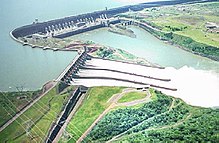
Satellite image of the ria of Bilbao. Its "left margin" is a classic industrial area.

Soviet propaganda cartel: "The Donbass" is the heart of Russia."

Air photography from Silicon Valley, a high-tech industrial area.

Itaipu dam, in the Paraná River, between Paraguay and Brazil.
Industrial geography is a branch of geography that studies industrial uses in the geographic landscape. It is part of economic geography and human geography.
It aims to explain the relationship established between human groups and the environment in industrial landscapes, that is, humanized landscapes in which secondary sector activities are predominant.
The consequences of industrialization processes are among the most transformative of the geographical space and with the most environmental problems.
Industrial location factors
Main article: Industrial location
- Natural resources or raw materials
- Energy sources (initially coal for steam machines, later oil and electrification)
- Transport (allows access to raw materials and energy sources and output of products to markets; through roads, channels, ports, railways, etc.)
- Market (output of products)
- Workman (in the quantity and with the necessary qualification)
- Industrial concentration ("industry calls industry")
- Economic planning
- Endogenous development
Industrial crisis, conversion and restructuring
See also: Industrial crisis, Crisis of 1973, Industrial reconstruction and Industrial restructuring.
See also: Reindustrialization, Emergency zones reindustrialization, Industrial decline and Industrialized decline zones.
Deindustrialization and industrial relocation
Main articles: Deindustrialization, Industrial dislocation and Industrial equipment.
Abandoned auto factory in Detroit.
Industry Types
Main article: Types of industry

Coalbrookdale at night (Philipp Jakob Loutherbourg, 1801).

Amoskeag Mills 2(Charles Sheeler, 1948).

BrainPortEindhoven, with Philips Natuurkundig Laboratorium and the Technical University of Eindhoven (Peterhijs, 2006).
Industrial Landscapes
Since the 19th century, the First Industrial Revolution, based on the use of coal, gave rise to industrial landscapes traditional or "black landscapes" (Pays Noir). In the XX century, with the Second Industrial Revolution, the urban industrial landscapes, characterized by industrial estates around cities, and large petrochemical facilities in port areas. At the end of the 20th century and in the XXI, with the Third Industrial Revolution, Scientific-Technological Revolution or Digital Revolution, characterized by the knowledge economy and information and communication technologies (ICTs, which "outsource" industry), the modern "technopolis" appear.
- Industrial landscapes in Europe
Industrial Landscape of England (Sun 3 Channel Ashton, Manchester).
Industrial landscape in Germany, on the banks of the Rhine (Wesseling).
Industrial Landscape of France (nuclear installation of Creys-Malville).
Industrial landscape in Russia (ferroviary links and factories in Monchegorsk).
- Industrial landscapes in Asia
Industrial landscape in Japan, on the Pacific shores (Fukushima II - at that time under construction, the Fukushima I- nuclear accident subsequently occurred).
Industrial landscape in Japan (Takasago).
Industrial landscape in South Korea (GM Daewoo in Bupyeong-gu).
Industrial landscape in China (Suzhou Industrial Park -SIP-, a Singapore-based facility).
Industrial landscape in Vietnam (brick factory in Quillonng Ngãi).
Industrial landscape in Bangladesh (fertilizer factory in Shahjalal).
Industrial landscape in India (Bombay neighbourhoods).
Industrial Landscape in Iran (Petrochemical Complex Bandar Jomeiny).
Industrial landscape in Turkey (Erdemir residence).
- Industrial landscapes in América
Industrial landscape in the United States (Detroit).
Industrial landscape in the United States (Texas City Dike).
Industrial landscape on the border between Mexico and the United States (maquiladoras).
Industrial landscape in Brazil (ethanol and sugar factory in Pradopolis).
Industrial landscape in Argentina (kitchen factory in Villa Adelina).
- Industrial landscapes in Africa
Industrial landscape in Egypt (oil refinery in Lago Mariout).
Industrial landscape in Sudan (cotton factory in Nzara).
Industrial landscape in South Africa (refinery in Cape Town).
- Industrial landscapes in Oceania
Industrial landscape in Australia (electronic industry near Sydney).
Industrial geography in pre-industrial times
Main article: Pre-industrial society
The mills are a capital data of the industrial geography of the past. They occupy an important place in toponymy.... Until the development of steam engines, it was the energy user. Therefore, they were classified according to the natural sources of energy known by then in: windmill, water mill, tide mill.... According to the application of the energy, wheat, oil, sugar, casca, powder mills were distinguished to abatanar, paper, fragua, to dry the swamps or to raise the waters.
Pierre George, Geography Dictionary
Industrial areas
Main article: Industrial area

Main industrial areas of the world: the Northeast of the United States (from the Great Lakes to the Atlantic coast - the West Coast is also very industrialized), the North-West Europe (from Britain to the North of Italy and from the North of Spain to Germany) and the Far East (Japan, South Korea and East of China). The one in the West of Russia (together with the East of Ukraine) is a great traditional industrial area that with the crisis of the communist bloc (1989) and the transition to capitalism was relatively lagged and obsolete; later it was revived, as a result of globalization, along with the so-called new industrialized countries among which the ones identified with the acronym BRIC (Brazil, Russia, India and China). Cartographically eccentric, but geographically integrated into the "north" or "center" world, Australia and New Zealand are considered industrialized countries since this concept was defined (middle the century)
XX.).
Más resultados...









![Paisaje industrial en Alemania, a orillas del Rin (Wesseling).[9]](https://upload.wikimedia.org/wikipedia/commons/thumb/7/70/Wesseling_Germany_Evonik-Industries-01.jpg/120px-Wesseling_Germany_Evonik-Industries-01.jpg)
![Paisaje industrial de Francia (instalación nuclear de Creys-Malville).[10]](https://upload.wikimedia.org/wikipedia/commons/thumb/7/76/Superph%C3%A9nix.jpg/120px-Superph%C3%A9nix.jpg)


![Paisaje industrial en Japón (Takasago).[11]](https://upload.wikimedia.org/wikipedia/commons/thumb/6/64/Takasago2006.jpg/120px-Takasago2006.jpg)

![Paisaje industrial en China (Suzhou Industrial Park[12] -SIP-, una instalación con participación de Singapur).](https://upload.wikimedia.org/wikipedia/commons/thumb/5/5f/Suzhou_Industrial_Park_%28SIP%29_-_West_Bank_of_Jin_Ji_Lake.jpg/120px-Suzhou_Industrial_Park_%28SIP%29_-_West_Bank_of_Jin_Ji_Lake.jpg)




![Paisaje industrial en Turquía (siderurgia de Erdemir).[13]](https://upload.wikimedia.org/wikipedia/commons/thumb/6/64/Erdemir_Demir.jpg/120px-Erdemir_Demir.jpg)

![Paisaje industrial en Estados Unidos (Texas City Dike).[14]](https://upload.wikimedia.org/wikipedia/commons/thumb/b/b4/Texas_city_dike_industry.jpg/120px-Texas_city_dike_industry.jpg)

![Paisaje industrial en Brasil (fábrica de etanol y azúcar en Pradópolis).[15]](https://upload.wikimedia.org/wikipedia/commons/thumb/f/f9/Usina_S%C3%A3o_Martinho%2C_F%C3%A1brica_de_A%C3%A7ucar_e_Etanol_-_Prad%C3%B3polis.jpg/120px-Usina_S%C3%A3o_Martinho%2C_F%C3%A1brica_de_A%C3%A7ucar_e_Etanol_-_Prad%C3%B3polis.jpg)





